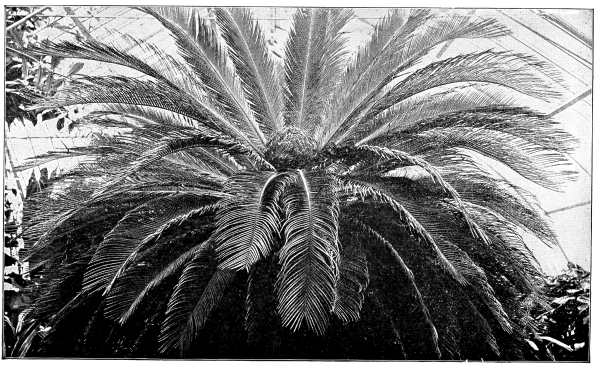
Cycas revoluta (see page 311).
ELEMENTARY BOTANY
BY
GEORGE FRANCIS ATKINSON, Ph.B.
Professor of Botany in Cornell University
THIRD EDITION, REVISED

NEW YORK
HENRY HOLT AND COMPANY
1905
Copyright, 1898, 1905
BY
HENRY HOLT AND COMPANY
ROBERT DRUMMOND, PRINTER, NEW YORK
PREFACE.
The present book is the result of a revision and elaboration of theauthor’s “Elementary Botany,” New York, 1898. The general plan of theparts on physiology and general morphology remains unchanged. A numberof the chapters in the physiological part are practically untouched,while others are thoroughly revised and considerable new matter isadded, especially on the subjects of nutrition and digestion. Theprincipal chapters on general morphology are unchanged or only slightlymodified, the greatest change being in a revision of the subject ofthe morphology of fertilization in the gymnosperms and angiosperms inorder to bring this subject abreast of the discoveries of the past fewyears. One of the greatest modifications has been in the addition ofchapters on the classification of the algæ and fungi with studies ofadditional examples for the benefit of those schools where the timeallowed for the first year’s course makes desirable the examination ofa broader range of representative plants. The classification is alsocarried out with greater definiteness, so that the regular sequenceof classes, orders, and families is given at the close of each of thesubkingdoms. Thus all the classes, all the orders (except a few in thealgæ), and many of the families, are given for the algæ, fungi, mosses,liverworts, pteridophytes, gymnosperms, and angiosperms.
But by far the greatest improvement has been in the completereorganization, rewriting, and elaboration of the part dealing withecology, which has been made possible by studies of the past few years,so that the subject can be presented in a more logical and coherent[Pg iv]form. As a result the subject-matter of the book falls naturally intothree parts, which may be passed in review as follows:
Part I. Physiology. This deals with the life processes of plants,as absorption, transpiration, conduction, photosynthesis, nutrition,assimilation, digestion, respiration, growth, and irritability. Sinceprotoplasm is fundamental to all the life work of the plant, thissubject is dealt with first, and the student is led through the studyof, and experimentation with, the simpler as well as some of the higherplants, to a general understanding of protoplasm and the special way inwhich it enables the plant to carry on its work and to adjust itself tothe conditions of its existence. This study also serves the purpose offamiliarizing the pupil with some of the lower and unfamiliar plants.
Some teachers will prefer to begin the study with general morphologyand